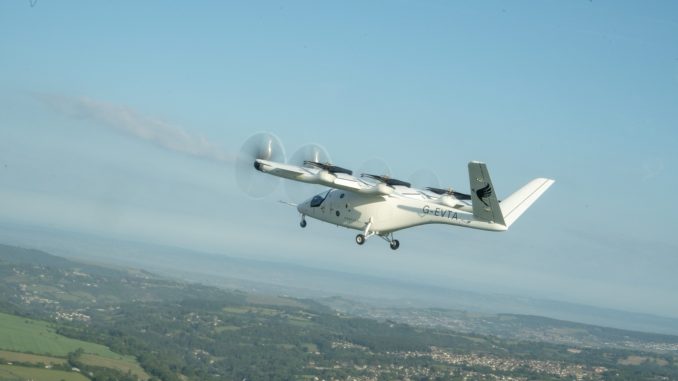
Vertical Aerospace today announced it has made a piloted wingborne flight of a winged electric vertical take-off and landing (eVTOL) aircraft in open airspace. This is a European first, says the company.
“The landmark flight of the VX4 prototype, piloted by Chief Test Pilot Si Davies, saw the aircraft take-off, fly and land like a conventional aircraft, with lift generated by the wing,” said the company in a press release. “Soaring across the UK countryside from Cotswolds Airport, the VX4 prototype demonstrated controlled wingborne flight in open airspace for the first time, marking a critical step toward commercial deployment as part of Vertical’s Flightpath 2030 strategy. “
The UK Civil Aviation Authority (CAA) approved the flight through open airspace at Cotswolds Airport by extending Vertical’s Permit to Fly. This followed a rigorous review of tens of thousands of pages of safety and technical documentation.
Chief Test Pilot, Simon Davies, said: “Taking the aircraft beyond the airfield and cruising over the Cotswolds for the first time was truly special and a career highlight for me. Our performance predictions were absolutely spot on, and the aircraft took off as a natural extension of all the ground tests and preparation we’ve done. There are aircraft which are safe and capable but not always enjoyable to fly. The VX4 was not only safe but was an absolute pleasure. It is responsive, smooth, simple to operate and the sound level from the propellers is quiet and pleasant in the cockpit. An honour to fly, and a real testament to the incredible team behind it.”
Vertical reports it is currently the only company globally flying a piloted winged eVTOL prototype that has been been developed under a Design Organisation Approval (DOA) from the CAA – a DOA is required to hold a Type Certificate, required for commercial passenger operations. The CAA is working closely with the European Union Aviation Safety Agency (EASA) for their concurrent validation and certifying the VX4 to the highest safety standards required for commercial use.
Stuart Simpson, CEO, Vertical Aerospace, said: “Achieving piloted wingborne flight in open airspace under the oversight of the UK CAA is an important moment in our certification journey. Operating under the UK’s rigorous regulatory framework means we share the burden of safety with our regulator – every step must be approved, and that’s by design. It amounts to a mini certification of our prototype and gives us a clearer, faster path to type certification.
Our decision to put a pilot into the VX4 early was deliberate – real-world piloted flight delivers insights no simulation can. This milestone proves the capability of the aircraft and the maturity of our programme as we move toward commercial operations.”
This achievement has also been supported by early UK government investment through programmes including the Aerospace Technology Institute and the Future Flight Challenge. These initiatives have contributed to the development of Vertical’s technology and flight test campaign, and form part of wider efforts to advance the UK’s net zero and aerospace ambitions.
In Phase three of testing – wingborne flight – the VX4 operates like a conventional aircraft using lift generated by its wings, rather than relying solely on rotor thrust. This low-power, quiet, and range-efficient mode of flight is key to making electric air travel practical, scalable, and economically viable. The next major milestone for Vertical is a full piloted transition flight, expected in the second half of 2025. This will demonstrate the VX4’s ability to shift seamlessly between vertical lift and forward cruise – the operating mode it will use in passenger service.
During the wingborne flight phase, the VX4 will reach speeds of up to 150 mph (120 knots) and altitudes close to 2,000 ft under real-world conditions. Engineers captured more than 30,000 in-flight data parameters, confirming the aircraft performed exceptionally across stability, control, and energy usage.
For more information
www.vertical-aerospace.com

